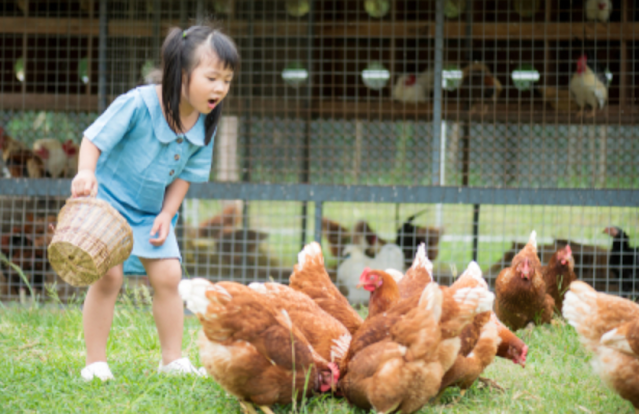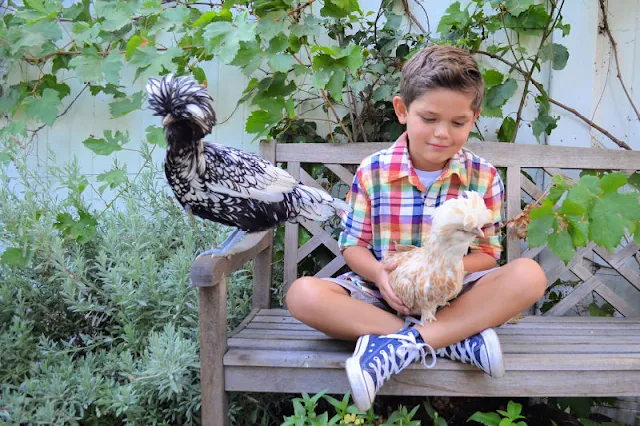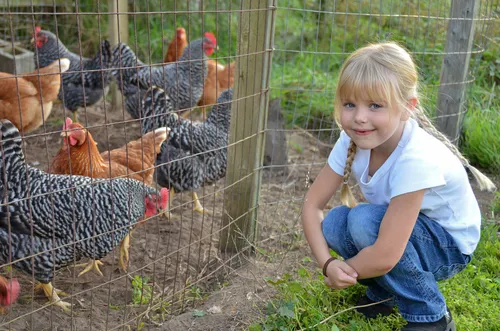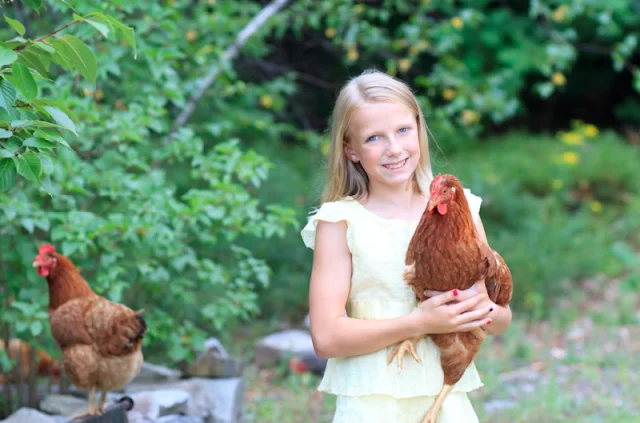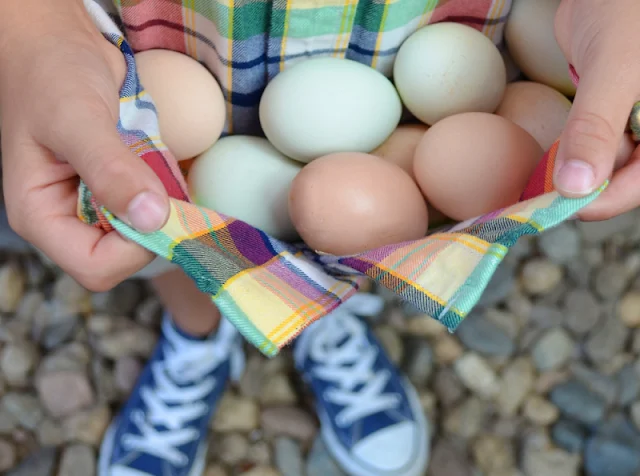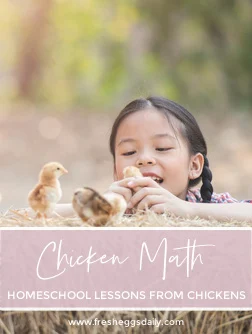In addition to providing fresh, delicious eggs, a flock of backyard chickens offers a multitude of learning lessons for homeschooling children.
Backyard chickens, like dogs, cats and bunnies, make wonderful family pets.
But unlike raising a dog, cat or even a bunny, raising a flock of chickens provides a multitude of learning experiences for homeschooling children beyond the basic chores.
In addition to teaching kids responsibility and routine, chicken chores help get kids outside, interested in learning where their food comes from and also can teach basic math, history and other skills.
Kids of all ages can learn important life lessons from backyard chickens.
Homeschool Lessons for Children from Backyard Chickens
Raising chickens can be extremely educational. In addition to teaching kids responsibility and learning that daily chores are essential, caring for chickens also teaches them empathy for animals.
It teaches them that even if your chickens are ultimately providing food for your family, treating them with care and gentleness is still important.
Raising chickens also shows kids where their food comes from, emphasizes the importance of eating fresh and local food AND enjoy fresher, more nutritious meals!
Building a chicken coop and safe, specious run or pen for the chickens can be a great family activity letting everyone get involved in the design and building, choosing paint colors and painting the coop, and planting flowers in window boxes and around the coop.
But there are lots more lessons to be learned from backyard chickens. Raising chickens can be a great math learning tool for parents who homeschool kids of all ages.
Even if you're not homeschooling your kids, there are still all kinds of things to teach them not only about raising chickens, but to practice the lessons they learn in school.
Chicken Math
Those of us with backyard flocks call it "chicken math". Three chickens somehow turns into six, which turns into a dozen and before you know it, you've got three dozen chickens running around your backyard.
Counting your chickens before they hatch is generally not recommended, but counting eggs can definitely help teach kids math!
Young children can simply count the eggs collected, while you can teach older children fractions and ratios using eggs and egg cartons.
Word problems using different scenarios can make math more fun. Of course the difficulty can be adjusted for the age of your children.
For example:
- We have 5 chickens in the coop. If one runs away and hides under a bush, how many chickens do we have now?
- We have 3 chickens currently. If we go to the feed store and buy 5 more, now how many chickens do we have?
- I have a basket with 14 eggs in it. If I break 6, how many eggs will I be left with?
- We have 3 chickens, Grandpa has 4 chickens and cousin Amanda has 7 chickens. How many chickens is that total?
- If we have 10 chickens and we collected 6 eggs, how many chickens didn't lay an egg today? (for older kids, it could be a percentage math problem instead)
- We have a dozen eggs and need 3 eggs to bake a cake. After we bake the cake, how many eggs will we have left?
- Our hen is sitting on 9 eggs. If 30% of the eggs hatch? How many chicks will she have?
- We have a bowl of 12 strawberries. If we have 4 chickens and divide the berries evenly among them, how many berries will each chicken get?
- We have 4 chickens and collected 24 eggs this week. How many eggs on average did each chicken lay?
- If we have 24 chickens and 40% of the hens lay an egg today, how many eggs will we collect?
Geography and History Homeschool Lessons from Backyard Chickens
Kids can learn geography by researching where the various breeds of chickens originated, learning about those countries and pointing them out on a map or globe.
They can learn about the history of the country as well as the breed, point out their different characteristics that make them suited to the climate where they came from, and find out when they came to the United States.
Kids can also have fun learning the word for "chicken" in different languages.
Science and Anatomy Homeschool Lessons from Backyard Chickens
Learning the different parts of an egg can be fascinating. For younger kids, pointing out the shell, white and yolk is probably sufficient, while older kids can learn all about the membranes, chalazae and germinal disc, and their various functions.
Researching and drawing the chicken reproductive system is another great learning lesson. Younger kids can practice drawing chickens and labeling the different body parts, head, legs, wings, etc. Age-Appropriate Chicken Chores for Children of Different Ages
Depending on the ages of your kids, they can be assigned a variety of age-appropriate "chicken chores" and also other homeschooling lessons based on their age. Of course supervision is essential, especially at first and with the smaller kids.
And since each child is different, the ages are simply guidelines, but you will quickly learn what your individual child is capable of.
Little Kids (Ages 2 to 5)
Little kids can get involved with raising chickens in various ways including:
- helping to look for eggs (although you need to be prepared for a fair amount of breakage!)
- tossing treats to the chickens from a small pail
Little ones can practice counting skills by counting the eggs in their basket. They can learn some basic math skills by adding or taking away eggs from a carton.
They can practice their colors by naming the colors of various eggs or arranging them by color. They can even try to count the chickens (although counting eggs is a LOT easier!)
Since kids under the age of 5 years are most susceptible and more apt to contract salmonella, its best to keep a very close eye on children this young when they are around the chickens to be sure they aren't coming in contact with dirty eggs or excessive chicken manure, etc. and not putting their fingers in their mouth.
Older Kids (6 to 12)
Older kids can handle more important chores including:
- letting the chickens out in the morning
- helping to fill feeders and waterers
- watching the chickens while they are in the yard
- keeping the nesting boxes full of bedding
- helping to get the chickens back into the coop at night (although an adult should always double-check that the coop is properly locked up for the night
They can keep track of how many eggs they collect each day on a spreadsheet and help do a headcount of all the chickens once they're all on the roosts for the night.
Teens (13 to 16)
Older kids with a year or two of chicken chores under their belt will likely be able to handle most chores on their own with minimal supervision or checking on them. Teens can obviously handle far more responsibility for the chickens including:
- locking the chickens up at night (although its always a good idea to have a parent double check that the coop has been locked and everyone is inside)
- carrying heavier bags of feed or shavings
- helping to clean out the chicken coop
- scrubbing feeders and waterers when they need to be cleaned
- making sure the chickens have plenty of feed and water
Teens can calculate how much feed each chicken eats and put together a budget for feed, coop bedding, treats and supplements and how much it costs to raise their chickens per week or month.
They can figure out daily and weekly egg production averages or annual forecasts. And they can do more difficult math problems like how many chickens will fit in a coop of a specific size.
They could even start an egg business, learning how to decide how much to charge for the eggs and how to calculate profits.
Cooking with Eggs
Kids of all ages will enjoy cooking and baking with the fresh eggs. Starting with easy recipes like scrambled or hard boiled eggs, then moving to more complicated things such as egg salad, ice cream, pancakes or cakes and cupcakes.
Let your kids choose pictures of foods they would like to learn how to make (or watch you make!) from magazines or food blogs and then get them involved in as much of the preparation as you can.
Yummy treats are a good incentive to keep kids interested in the care of the chickens to make the chores be more enjoyable and rewarding.
Bottom line, a flock of backyard chickens can provide so many benefits besides fresh eggs, for all families, but especially for children being homeschooled or home doing virtual learning.
Homeschool lessons learned from backyard chickens will make learning more fun for everyone. Chicken math is real, and chickens really do make wonderful pets!
Pin This!
Further ReadingBeginners Guide to Raising Backyard ChickensBeginners Guide to Raising ChicksKid-Friendly Chicken Breeds

Follow me on your favorite social media channel!
Facebook | Twitter | Instagram | YouTube | Subscribe
©2021 by Fresh Eggs Daily, Inc. All rights reserved






